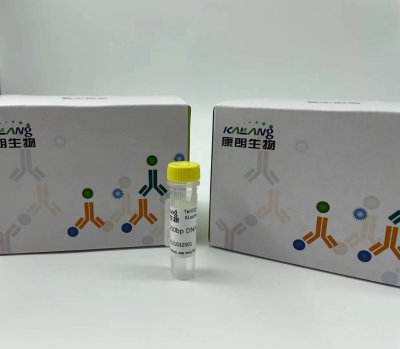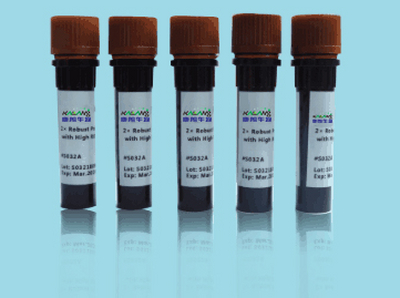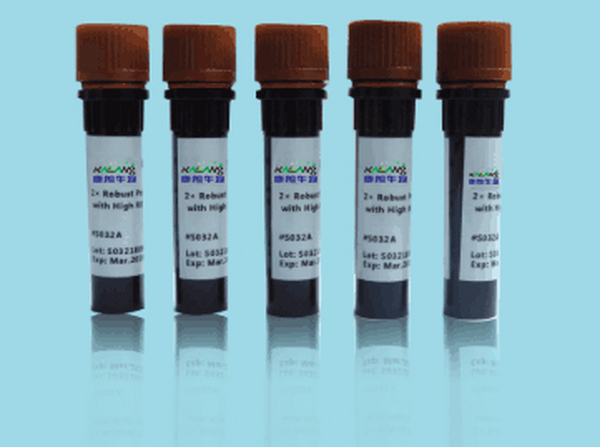QQ:3002763590


客服电话:021-61998208
Cytokeratin 8 rabbit Polyclonal Antibody
Cytokeratin 8抗体
Cytokeratin 8抗体应用:Western Blot: 1/500 - 1/2000. Immunohistochemistry: 1/100 - 1/300. Immunofluorescence: 1/200 - 1/1000. ELISA: 1/40000.keratin 8(KRT8) Homo sapiens This gene is a member of the type II keratin family clustered on the long arm of chromosome 12. Type I and type II keratins heteropolymerize to form intermediate-sized filaments in the cytoplasm of epithelial cells. The product of this gene typically dimerizes with keratin 18 to form an intermediate filament in simple single-layered epithelial cells. This protein plays a role in maintaining cellular structural integrity and also functions in signal transduction and cellular differentiation. Mutations in this gene cause cryptogenic cirrhosis. Alternatively spliced transcript variants have been found for this gene. [provided by RefSeq, Jan 2012],
Cytokeratin 19 rabbit Polyclonal Antibody
Cytokeratin 19抗体
Cytokeratin 19抗体应用:Western Blot: 1/500 - 1/2000. Immunohistochemistry: 1/100 - 1/300. ELISA: 1/10000.keratin 19(KRT19) Homo sapiens The protein encoded by this gene is a member of the keratin family. The keratins are intermediate filament proteins responsible for the structural integrity of epithelial cells and are subdivided into cytokeratins and hair keratins. The type I cytokeratins consist of acidic proteins which are arranged in pairs of heterotypic keratin chains. Unlike its related family members, this smallest known acidic cytokeratin is not paired with a basic cytokeratin in epithelial cells. It is specifically expressed in the periderm, the transiently superficial layer that envelopes the developing epidermis. The type I cytokeratins are clustered in a region of chromosome 17q12-q21. [provided by RefSeq, Jul 2008],
Cytokeratin 4 rabbit Polyclonal Antibody
Cytokeratin 4抗体
Cytokeratin 4抗体应用:WB 1:500-2000, ELISA 1:10000-20000 keratin 4(KRT4) Homo sapiens The protein encoded by this gene is a member of the keratin gene family. The type II cytokeratins consist of basic or neutral proteins which are arranged in pairs of heterotypic keratin chains coexpressed during differentiation of simple and stratified epithelial tissues. This type II cytokeratin is specifically expressed in differentiated layers of the mucosal and esophageal epithelia with family member KRT13. Mutations in these genes have been associated with White Sponge Nevus, characterized by oral, esophageal, and anal leukoplakia. The type II cytokeratins are clustered in a region of chromosome 12q12-q13. [provided by RefSeq, Jul 2008],
D106A rabbit Polyclonal Antibody
D106A抗体
D106A抗体应用:IHC-p 1:50-200 Defensins form a family of antimicrobial and cytotoxic peptides made by neutrophils. Defensins are short, processed peptide molecules that are classified by structure into three groups: alpha-defensins, beta-defensins and theta-defensins. All beta-defensin genes are densely clustered in four to five syntenic chromosomal regions. Chromosome 8p23 contains at least two copies of the duplicated beta-defensin cluster. This duplication results in two identical copies of defensin, beta 106, DEFB106A and DEFB106B, in head-to-head orientation. This gene, DEFB106A, represents the more centromeric copy. [provided by RefSeq, Oct 2014],
D1DR rabbit Polyclonal Antibody
D1DR抗体
D1DR抗体应用:Western Blot: 1/500 - 1/2000. Immunohistochemistry: 1/100 - 1/300. Immunofluorescence: 1/200 - 1/1000. ELISA: 1/5000. dopamine receptor D1(DRD1) Homo sapiens This gene encodes the D1 subtype of the dopamine receptor. The D1 subtype is the most abundant dopamine receptor in the central nervous system. This G-protein coupled receptor stimulates adenylyl cyclase and activates cyclic AMP-dependent protein kinases. D1 receptors regulate neuronal growth and development, mediate some behavioral responses, and modulate dopamine receptor D2-mediated events. Alternate transcription initiation sites result in two transcript variants of this gene. [provided by RefSeq, Jul 2008],
D3DR rabbit Polyclonal Antibody
D3DR抗体
D3DR抗体应用:Western Blot: 1/500 - 1/2000. ELISA: 1/20000. dopamine receptor D3(DRD3) Homo sapiens This gene encodes the D3 subtype of the five (D1-D5) dopamine receptors. The activity of the D3 subtype receptor is mediated by G proteins which inhibit adenylyl cyclase. This receptor is localized to the limbic areas of the brain, which are associated with cognitive, emotional, and endocrine functions. Genetic variation in this gene may be associated with susceptibility to hereditary essential tremor 1. Alternative splicing of this gene results in transcript variants encoding different isoforms, although some variants may be subject to nonsense-mediated decay (NMD). [provided by RefSeq, Jul 2008],
D4DR rabbit Polyclonal Antibody
D4DR抗体
D4DR抗体应用:Western Blot: 1/500 - 1/2000. Immunofluorescence: 1/200 - 1/1000. ELISA: 1/40000. dopamine receptor D4(DRD4) Homo sapiens This gene encodes the D4 subtype of the dopamine receptor. The D4 subtype is a G-protein coupled receptor which inhibits adenylyl cyclase. It is a target for drugs which treat schizophrenia and Parkinson disease. Mutations in this gene have been associated with various behavioral phenotypes, including autonomic nervous system dysfunction, attention deficit/hyperactivity disorder, and the personality trait of novelty seeking. This gene contains a polymorphic number (2-10 copies) of tandem 48 nt repeats; the sequence shown contains four repeats. [provided by RefSeq, Jul 2008],
D54 rabbit Polyclonal Antibody
D54抗体
D54抗体应用:Western Blot: 1/500 - 1/2000. ELISA: 1/5000.tumor protein D52 like 2(TPD52L2) Homo sapiens This gene encodes a member of the tumor protein D52-like family. These proteins are characterized by an N-terminal coiled-coil motif that is used to form homo- and heteromeric complexes with other tumor protein D52-like proteins. Expression of this gene may be a marker for breast cancer and acute lymphoblastic leukemia. Alternatively spliced transcript variants encoding multiple isoforms have been observed for this gene, and a pseudogene of this gene is located on the long arm of chromosome 12. [provided by RefSeq, Aug 2011],
D55 rabbit Polyclonal Antibody
D55抗体
D55抗体应用:Immunohistochemistry: 1/100 - 1/300. ELISA: 1/20000.tumor protein D52 like 3(TPD52L3) Homo sapiens This gene encodes a member of the tumor protein D52-like family of proteins. These proteins are characterized by an N-terminal coiled-coil motif that is used to form homo- and heteromeric complexes with other tumor protein D52-like proteins. The encoded protein may play a role in spermatogenesis. Alternative splicing results in multiple transcript variants. [provided by RefSeq, Oct 2009],
DAAM1 rabbit Polyclonal Antibody
DAAM1抗体
DAAM1抗体应用:WB 1:500-2000, ELISA 1:10000-20000 dishevelled associated activator of morphogenesis 1(DAAM1) Homo sapiens Cell motility, adhesion, cytokinesis, and other functions of the cell cortex are mediated by reorganization of the actin cytoskeleton and several formin homology (FH) proteins have been associated with these processes. The protein encoded by this gene contains two FH domains and belongs to a novel FH protein subfamily implicated in cell polarity. A key regulator of cytoskeletal architecture, the small GTPase Rho, is activated during development by Wnt/Fz signaling to control cell polarity and movement. The protein encoded by this gene is thought to function as a scaffolding protein for the Wnt-induced assembly of a disheveled (Dvl)-Rho complex. This protein also promotes the nucleation and elongation of new actin filaments and regulates cell growth through the stabilization of microtubules. Alternative splicing results in multiple transcript variants encoding distinct
最新动态
-

Anti-GNGT1 KL20092-001(50ul)
2021-10-11 -

Anti-GNGT1 antibody(50ul) KL20093-001
2021-10-11 -

α-tubulin mouse Monoclonal Antibody
2021-01-08 -

α-tubulin mouse Monoclonal Antibody(8F11)
2021-01-08
热门标签
- Histone H3 rabbit Polyclonal Antibody Histone H3抗体
- EGFR rabbit Polyclonal Antibody EGFR抗体
- Cy3 Conjugated
- AbFluor™ 555 Conjugated
- AbFluor™ 680 Conjugated
- AbFluor™ 350 Conjugated
- AbFluor™ 647 Conjugated
- AbFluor™ 594 Conjugated
- AbFluor™ 405 Conjugated
- Cy5 Conjugated
- AbFluor™ 488 Conjugated
- Cyclophilin B抗体 Cyclophilin B Monoclonal Antibody(2B10)
- COX IV抗体 COX IV Monoclonal Antibody(6C8)
- PCNA抗体 PCNA Monoclonal Antibody(12D10)
- FAK rabbit Polyclonal Antibody FAK抗体
邮箱:3002763590@qq.com
电话:021-61998208

扫码关注微信公众号






